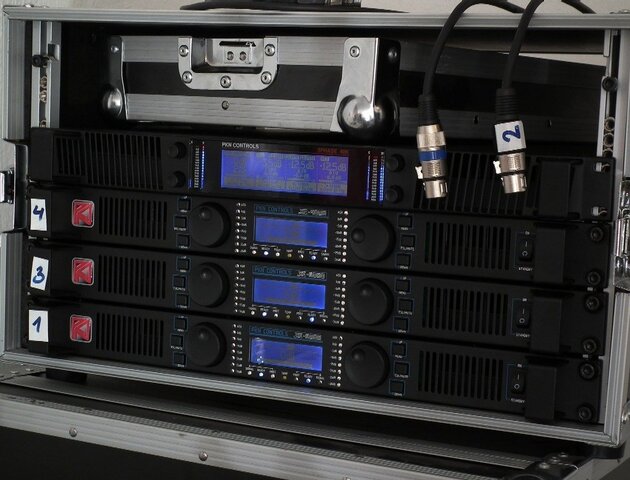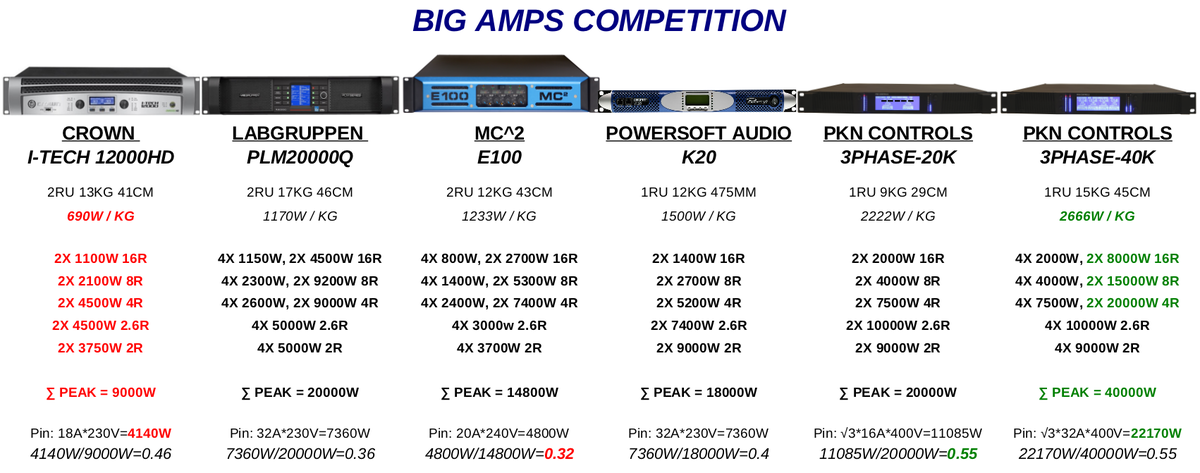I was just cruising around the web today and I came across these amplifiers, I was just curious if anybody has used these or what they thought of them. They seem like the kind of thing you would install in an arena or some place that needed allot of power but fewer amplification channels. The specs are just crazy for an amp that small. 4 channels at 4,000 watts into 8 ohms in a 1U rack space PKN Controls
You are using an out of date browser. It may not display this or other websites correctly.
You should upgrade or use an alternative browser.
You should upgrade or use an alternative browser.
Has anybody used these amps?
- Thread starterAman121
- Start date
LightTamer
Member
To put that much power in a 1 RU package, the fans must scream like a jet engine. They are probably fine in a permanent install situation where they are isolated in a clean, air conditioned room. But you wouldn't want them where noise is an issue or where environmental conditions are less than ideal. Ambient heat and dust would kill them.
I don't think these are a real product yet, they have shown prototypes but I don't believe they have a certified production model. You also have to read the specs carefully. For one thing, note that they do not identify any criteria for the power ratings, so I'm not sure quite what those number represent and how they may vary for different conditions. For another, look carefully at the power required, for example the four channel PKN-3PHASE-40K apparently requires 208V-480V (400V nominal), up to 32A (25A at 400V) power feeds in three phase mode and in single phase mode it seems to require a 90V-4275V (230V nominal), up to 80A (63A at 230V) power feed.
While the efficiency may be a factor, I don't see these being associated with permanent installs as much as with touring rigs where the reduced size and weight may be much more of a factor and where aspects such as apparently not being compatible with single phase NEMA receptacles may not be a consideration.
While the efficiency may be a factor, I don't see these being associated with permanent installs as much as with touring rigs where the reduced size and weight may be much more of a factor and where aspects such as apparently not being compatible with single phase NEMA receptacles may not be a consideration.
Wow, that's crazy. The amp needs its own company switch. I can't believe it is that dense. It's pretty lightweight as well. That gives a whole new meaning to "arc welder amp".
TimmyP1955
Well-Known Member
I don't think they are that different from the PowerSoft amps, which seem to have a very good reputation (and prices to match).
The PowerSoft amps work with more 'standard' 115V/230V single phase power systems, the three phase operation of the PKN Controls amps seems somewhat unique.I don't think they are that different from the PowerSoft amps, which seem to have a very good reputation (and prices to match).
Relevant to this discussion, while the outputs of a typical amplifier qualify for Class 2 wiring under NEC, amplifiers with higher voltage and higher current outputs may need to be addressed as Class 3 or even Class 1 wiring, the latter the same as AC power. This is often not identified in the specifications or product datasheets and can only be determined by looking at the rear panel of the amplifier where it should be labeled as to the Class wiring required. That can affect the wiring and connectors required to be used with the amplifier but in an installed application can also impact related conduit, boxes, terminations, etc.
I just don't see UL ever approving this. The power specs just don't match up with the connector on the back. The specs call for 80A in single phase mode, in the US that would require 4ga wire and a connector the size of a soup can. The 3 phase 480v is even worse, the pins in that connector in the middle look far to close to even consider putting 480 on no matter what the current level. The only UL approved connectors in the US that I am aware of for that voltage and current are all about 3 inches in diameter.
For these and other reasons I do not believe they can safely get the amount of power they are talking about into a 1u amp.
Sorry to be a downer, but that is my take on the matter.
Dover
For these and other reasons I do not believe they can safely get the amount of power they are talking about into a 1u amp.
Sorry to be a downer, but that is my take on the matter.
Dover
Not a stupid question at all. Probably easiest to look at the information Bob Lee at QSC offers here, QSC Audio Forum • View topic - NEC Class 1 Wiring for Audio. But rather than guessing, since it's what they AHJ or inspector will likely do, it's likely best to look at what the specific product you are using says on the rear panel. Also note that as Bob mentions, because a difference between Class 2 and Class 1/3 is the voltage and the difference between Class 1 and Class 3 is the current, an amplifier could have outputs rated as one Class for some modes and loads but as another Class for other modes and/or loads.So at what output ratings would you be required to use class 1 or 3 wiring?
Sorry if this is a stupid question.
It is nice to see here good European products. Our company is an "old user" of PKN, mainly their XD and XE series amps.
We do not have 3PHASE in our stages because it would be overkill in power but heard about highest level of good things about it from friends.
As I saw it has a military-grade circular connector for the AC input with break-before-make feature so No arcing is possible, I mean the unit draws current only after connected
and stops current before disconnect. While the XE and XD devices have standard Neutrik Speakon outputs the 3PHASE models have the "rugged type of NLT4M" Speakon.
It can do similar Voltage levels like other amps in bridged mode ~180Vrms per channel which is a pretty nice value for good headroom.
I measured one of our XE6000 which was able to make ~130Vrms on 8R so fits to the ratings of standard Speakon. Anyways tons of instructions written to the backplate but I do not think it would confrom to the US requirements Also it is much better to run amps on higher Voltage than US 110V.
Also it is much better to run amps on higher Voltage than US 110V.
They have a technical paper about the power supply, may written in not so good english but the graphs say all..
http://www.pknc.com/3phase/3phase_PSU.pdf
How understands basics of electronics will see this thing is lightyears more advanced than anything else.
We do not have 3PHASE in our stages because it would be overkill in power but heard about highest level of good things about it from friends.
As I saw it has a military-grade circular connector for the AC input with break-before-make feature so No arcing is possible, I mean the unit draws current only after connected
and stops current before disconnect. While the XE and XD devices have standard Neutrik Speakon outputs the 3PHASE models have the "rugged type of NLT4M" Speakon.
It can do similar Voltage levels like other amps in bridged mode ~180Vrms per channel which is a pretty nice value for good headroom.
I measured one of our XE6000 which was able to make ~130Vrms on 8R so fits to the ratings of standard Speakon. Anyways tons of instructions written to the backplate but I do not think it would confrom to the US requirements
They have a technical paper about the power supply, may written in not so good english but the graphs say all..
http://www.pknc.com/3phase/3phase_PSU.pdf
How understands basics of electronics will see this thing is lightyears more advanced than anything else.
Last edited:
Similar threads
- Replies
- 0
- Views
- 745
- Replies
- 0
- Views
- 743
- Replies
- 0
- Views
- 636
- Replies
- 9
- Views
- 4K
Users who are viewing this thread
Total: 1 (members: 0, guests: 1)




